on Level 3, EV sales, carbon fiber, H2 in the snow, Lexus RX
Mercedes goes Level 3 in Nevada. . .EV sales in ‘23. . .interesting Euro stats. . .cars with composites. . .heat with no subscription required. . .grooming snow with hydrogen. . .Lexus RX 500h review
Mercedes Goes Level 3: With All That Tech, No Wonder It’s In the S-Class
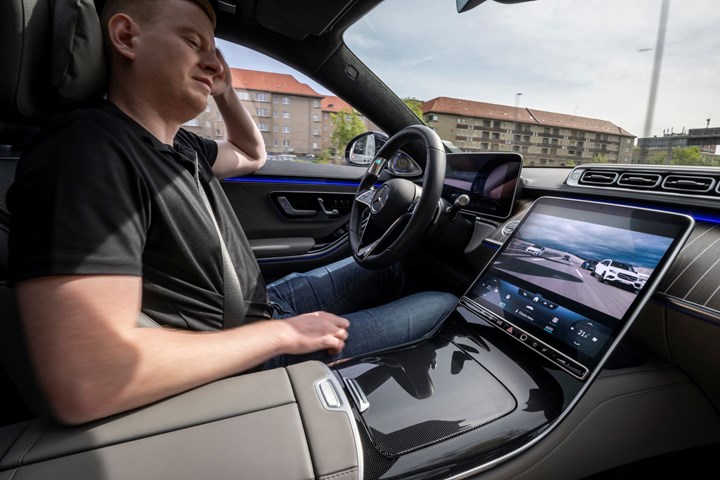
You might imagine that if you were able to keep your eyes off the road while driving your Level 3-capable Mercedes S-Class you wouldn’t be watching a screen with cars on it. Why not just drive if that’s what it is about? (Image: Mercedes)
“In the modern world, time is one of the most precious commodities, and giving back time to our customers is a core element in our strategy to build the world’s most desirable cars.”
That is Markus Schäfer, Member of the Board of Management of Mercedes-Benz Group AG, Chief Technology Officer, responsible for Development and Procurement.
He is referring to returning time to customers who buy either a 2024 S-Class or EQS sedan that’s equipped with the Mercedes-Benz DRIVE PILOT system.
According to Merc, that is “the first and only SAE Level 3 system in a standard-production vehicle authorized for use on U.S. public freeways.”
Not all U.S. public freeways, however.
Just those in Nevada.
And Mercedes “has the ambition to continue to expand to California later this year.”
Levels
For comparison, know that GM Super Cruise and Ford BlueCruise driver assistance systems are considered SAE Level 2+ (although SAE only uses whole numbers without suffixes). Still, the enhanced Level 2 keeps the driver with eyes on the road through giving him the ability to clap along to Queen like in the GMC truck commercial.
Level 3 keeps the driver in the seat, but in this case the driver could be reading a copy of Rolling Stone (or, given that this is an S-Class, The Financial Times) while keeping time to the tunes. The driver has to be ready to drive even though eyes on the road is not a requirement.
What It Needs
To get to this capability, there is plenty of tech.
For example, there’s the standard Driving Assistance Package in the S-Class that consists of:
- Front multi-mode radar: 2 radar sensors with an aperture angle of 130°
- Front long-range radar: 1 radar sensor with an aperture angle of 90° and 9°
- Front stereo multi-purpose camera: 1 camera with an aperture angle of 70°
- Rear multi-mode radar: 2 radar sensors with an aperture angle of 130°
- 360° camera (close range): 4 cameras with aperture angle of 180°
- Ultrasonic (close range): 12 sensors with an aperture angle of 120°
And supplementing that for the DRIVE PILOT system are:
- LiDAR
- A camera in the rear window
- A road-wetness sensor in the wheel well
- Redundant steering and braking actuators
- Redundant on-board electrical system
- High-precision (centimeter range) digital positioning system with the HD map stored in backend data centers
That said, the DRIVE PILOT system operates on suitable freeway sections and where there is high-density traffic.
It can operate at speeds up to 40 mph.
The driver is expected to be able to respond and take over operation of the vehicle within 10 seconds (which is why some companies are not keen on Level 3).
If there is no response, the vehicle safely maneuvers itself to a stop.
Keep This in Mind
An S-Class is just over 17 feet long and weighs nearly two-and-a-half tons.
Somehow it seems that paying attention wouldn’t be a bad thing to be doing while piloting the vehicle. . . .
///
More EVs in ’23—and Then Some
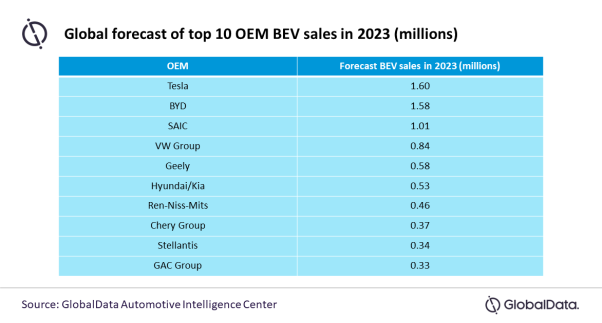
One thing to notice is that the only U.S.-based company is Tesla. Another thing is that Tesla’s lead is quite slim over China’s BYD. (Image: GlobalData)
Globally, electric vehicles will be up 41% in 2023 over 2022 predicts data and analytics company GlobalData.
That translates to about 11 million vehicles.
Al Bedwell, director of Global Powertrain at LMC (part of Global Data), notes that while EV sales in China will continue to lead the rest of the world, its “growth will moderate” in 2023 compared to 2022—but he also points out that in 2022 the EV sales in China grew 100% year-over-year.
Euro Sales
In Europe Bedwell sees growth of 50%. In 2022, largely due to the chip crisis, the EV market there grew “just 21%.”
North America?
The company predicts sales of over 1 million EVs in North America, representing a little better than 7% of the light-vehicle market.
However. . .
As these things happen, the GlobalData numbers were calculated before Tesla cut its prices in the U.S. and Europe, so that may have an effect.
And then there is this week’s Mustang Mach-E price cuts ranging from $900 to $5,900.
The Mach-E was the third best-selling EV in the U.S. in 2022 and Ford was number two in the U.S. in overall sales—in both cases well behind Tesla.
Still, EV price cuts by whomever in a market that has been characterized by ever-rising prices certainly is a good thing for consumers.
///
Fun Facts to Know & Tell: Euro Vehicle Edition
Did you know that in 2021 there were 249,563,035 vehicles on the road in the European Union, an increase of 1.2% compared with the number in 2020? Or that all EU countries save one increased their number of vehicles, with Slovenia being down 4.1%?
Of course you didn’t. But the people at the European Automobile Manufacturers Association do, and they compiled it in the “Vehicles in Use Europe 2023” report.
This one is rather astonishing:
- There are some 29.5 million vans rolling around in the EU. Half of them are in three countries: France (6.3 million), Italy (4.3 million) and Spain (3.9 million)
Age-wise, cars and light commercial vehicles average the same: 12 years. Trucks are on average 14.2 years old.
- The Greeks like to hang on to their vehicles. The average age of the car fleet in Greece (tied with Estonia) is 17 years old. The average age of the Greek truck fleet: 22.7 years.
On the subject of propulsion systems:
- Cars with plugs (full EVs and PHEVs) account for 1.5% of the total car fleet.
- Diesels account for 91% of the light commercial fleet. Only 0.6% are EVs.
The highest density of cars? Luxembourg: 698 per 1,000 vehicles.
The lowest? Romania: 396.
///
A Few More Euro Numbers. . .
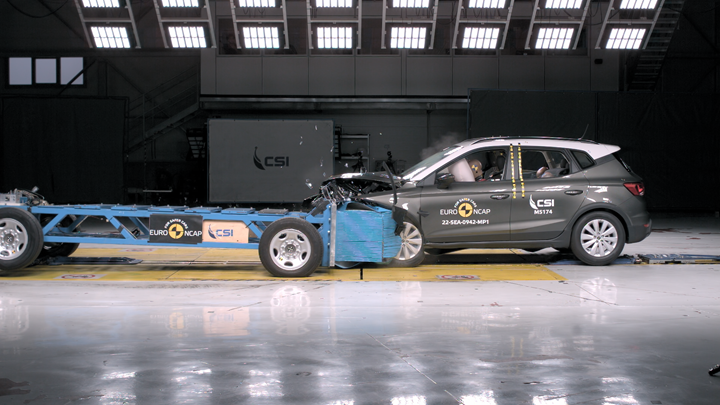
SEAT Arona received five stars in Euro NCAP testing. (Image: Euro NCAP)
These numbers are from Euro NCAP, the organization that performs vehicle crash tests and provides rating as a result of them. . .
- In 2022 65 cars were tested. 15 received four stars. 50 received five (the top).
- Of the 65, 22 were full EVs
- 17 were some hybrid type
- Seven brands had vehicles tested for the first time. Six of the seven are Chinese.
They’ve found that vehicles are getting heavier. As in these average weights.
- Small family car, 2010-2012: 3,003 lb.
- Small family car, 2020-2022: 3,181 lb.
- Small family car EV, 2022: 3,653 lb.
And
- Large family car, 2010-2012: 3,437 lb.
- Large family car, 2020-2022: 3,944 lb.
- Large family car EV, 2022: 4,414 lb.
And
- Small SUV, 2010-2012: 3,481 lb.
- Small SUV, 2021-2022: 3,785 lb.
- Small SUV EV, 2022: 4,361 lb.
The folks from Euro NCAP note about that: “While increased vehicle mass is not necessarily detrimental for self-protection, excessive mass and incompatible weight classes of vehicles on our roads, are a growing concern.”
Seems like some mass reductions are in order, however.
///
Nissan GT-R NISMO & Carbon Fiber Composites
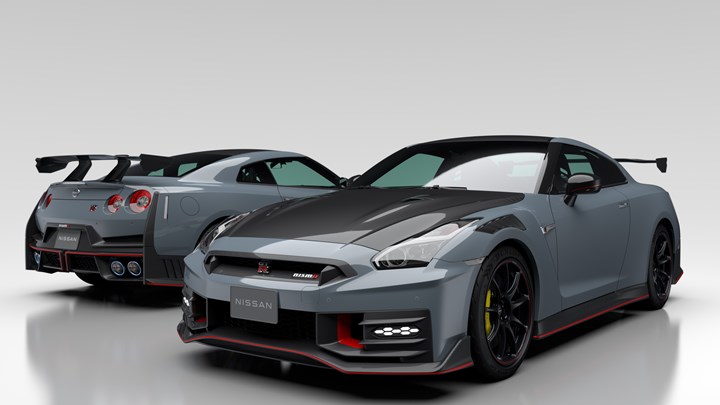
The ‘24 Nissan GT-R NISMO ups its performance, in part, through composites. (Image: Nissan)
The Nissan GT-R is, on the one hand, an exotic car, but on the other, something that is sold by the same company that makes trucks, crossovers and sedans.
Part of the exotic nature can be attributed to the overall rarity of the car in the U.S. market: last year Nissan sold 57 GT-Rs in the U.S.
Still, because this is a car that is sold not just around here, for the 2024 model year Nisan has announced some refreshes for the GT-R.
Versions
There are the Premium and the T-spec.
And the NISMO.
Which is interesting not just because it has a 600-hp all-aluminum, twin-turbo V6.
The NISMO has a new rear wing with a ~10% increase in surface area and revised front lip, rear diffuser and canards, all to increase downforce and reduce drag.
Addressing Mass
Beyond the aero there is attention to mass.
The GT-R NISMO features a carbon fiber roof, trunk, hood, fenders, side skirts, spoiler, and rear underbody diffuser.
Meanwhile, on the Premium and T-spec there is a carbon fiber rear underbody diffuser.
All models have a carbon fiber front cross member/core support.
A non-trival amount of carbon fiber, regardless of model.
However. . . NISMO has a curb weight of 3,867 pounds and the others 3,935 pounds.
Less mass. More horsepower.
The GT-R is produced at the Nissan plant in Tochigi, Japan.
And while on the subject of carbon fiber. . .
Colleagues at CompositesWorld, who obsessively cover the whole world of fiber-based materials and the like, saw the item in last week’s newsletter about recycling carbon fiber.
CW editor-in-chief Jeff Sloan points out, “There is a very steady drip-drip of activity in composites recycling.”
To that end, for those of you who are interested in that topic, you can see the CW’s collection of recycling pieces here.
And if you’re just interested in composites in general, you don’t want to overlook CompositesWorld.
///
Composites & Efficient Dynamics
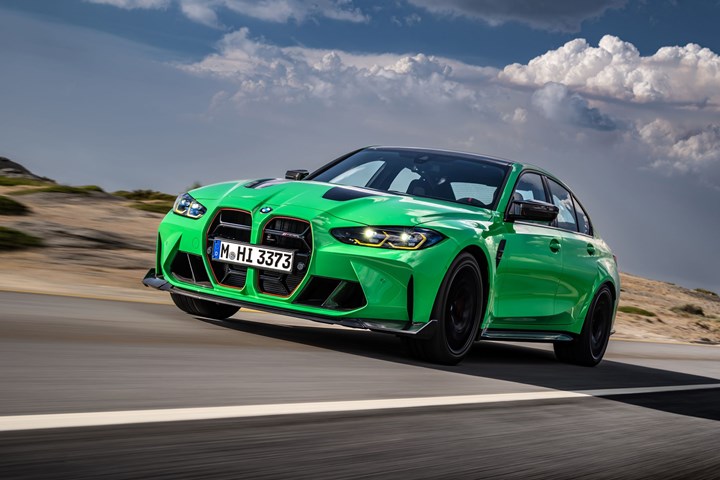
The BMW M3 CS in Individual Signal Green. Know that (1) that is an optional color and (2) the standard Black Sapphire and Brooklyn Grey are certainly more, well, sophisticated. (Image: BMW)
Meanwhile, over in Munich. . .
BMW has announced what it describes as the “very special, limited-edition 2024 BMW M3 CS,” which the company says will go from 0 to 60 mph in 3.2 seconds, powered by a 543-hp inline-six.*
But what’s of interest here is that this car uses plenty of carbon fiber reinforced plastic parts, too.
As in:
- Hood
- Roof
- Front splitter
- Front air intakes
- Exterior mirror caps
- Rear diffuser
- Rear spoiler
And while that’s all on the outside, the material is used inside, too:
- Center console
- Shift paddles
- Bucket seats
- Trim
While not carbon fiber, the rear silencer for the exhaust system is worth noting: It is made with titanium.
BMW reckons that the compared to the M3 Competition with M xDrive, the car upon which it is based, the M3 CS is, because of these and other mass-saving efforts, 75 pounds lighter. (To say nothing of having a simpler name.)
Its curb weight is 3,915 pounds.
The MSRP for the limited-edition model that will go into production at BMW Group Plant Munich in March is $118,700.
==
*One interesting aspect of the engine is that to cast the cylinder head they used a 3D-printed core that allows the coolant ducts to be optimally routed in a way that BMW says would be impossible to achieve with conventional casting methods.
///
Simple Tech vs. Subscriptions

Want a heated seat? Just add hot water. (Image: Dacia)
As more and more OEMs are interested in providing subscriptions for things in the vehicles that they build (for purposes of setting up continuing revenue streams), earlier this week European OEM Dacia had a bit of fun in the U.K.
Recognizing that competitive companies are talking about making people subscribe to heated seats, and given that in the northern hemisphere it is winter, Dacia, part of Renault, offered “Heated Seat Saviours” to those who visited its U.K. dealerships.
More simply known as “hot water bottles.”
“Our 'Heated Seat Saviours' are a bit of fun, but they do highlight the direction the wider industry is going regarding subscription-based access to features. Asking someone to pay extra to activate factory-fitted equipment certainly isn’t Dacia! We believe in simplicity, offering our customers technology that makes driving more convenient and comfortable with features included in a car’s initial price. Whether consumers view heated seats as essential or not, our commitment to value and a fuss-free ownership experience means that we will only ever ask them to push a button to enjoy them.”
That’s Luke Broad, Dacia Brand Director for the U.K.
Presumably his tongue was at least partially in his cheek.
Dacia offers heated seats as standard in its top-trim Sandero Stepway, Duster and Jogger models.
And it points out: “you don’t pay to turn them on.”
///
No One Wants to Smell Diesel in the Alps
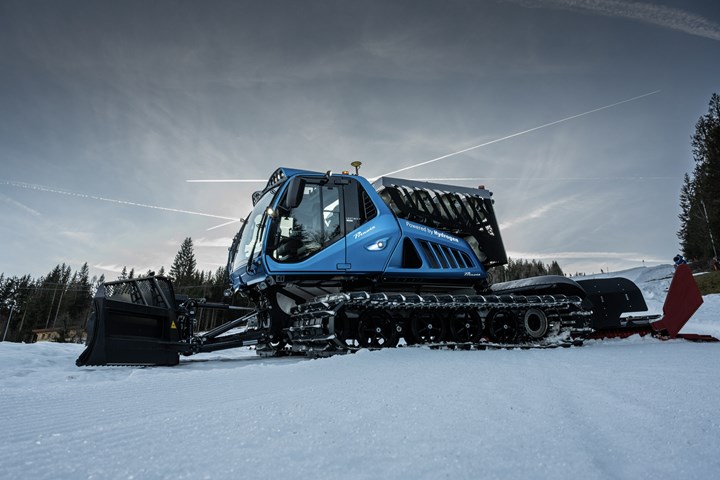
Concept snow groomer uses a combustion engine that runs on hydrogen. (Image: ©SNOWSPACESALZBURG)
Still on the subject of winter. . .
While the sports world was probably most interested in Mikaela Shiffrin tying Lindsey Vonn’s record at the Ski World Cup in Flachau last month, the environmental community might have been more interested in something else that occurred on the slopes: the introduction of the PRINOTH LEITWOLF h2MOTION, a concept snow groomer.
The machine is powered by a 13-liter, six-cylinder engine that produces 460 hp and 2,000 Nm of torque.
And notably, the FPT X13 in this application runs on hydrogen.
FPT Industrial designed the base X13 engine so that it can be configured to run on various fuels, including diesel.
And to that point, Klaus Tonhäuser, president and CEO of PRINOTH Group, noted: “The FPT Industrial engine of the LEITWOLF h2MOTION is similar to a diesel engine, and offers our customers what they are used to from other machines. This will contribute to the acceptance of the technology.”
The vehicle stores the hydrogen in five tanks. There is a sufficient quantity to allow the groomer to operate for about three hours before refueling.
///
Lexus RX 350 AWD F SPORT
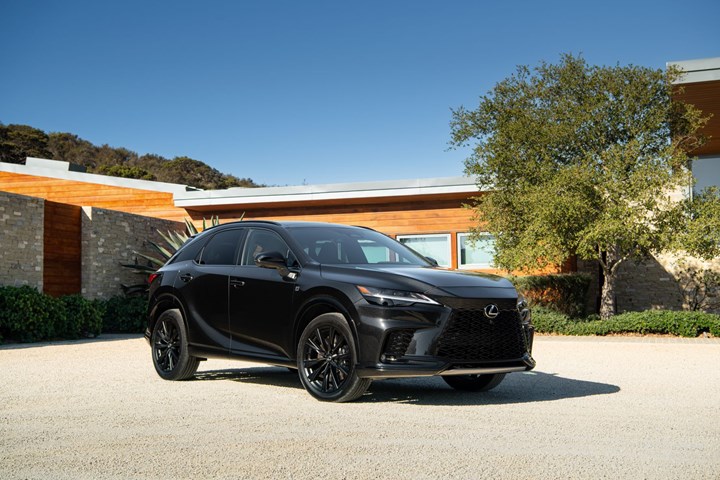
The Lexus RX 500h. Top-of-the-line performance for the new gen of RX vehicles. (Image: Lexus)
Koji Sato is the global head of Lexus and Toyota’s chief branding officer.
At least he will be for a few more weeks, because on April 1 Sato will become the CEO of Toyota Motors, the whole company.
That elevation probably has little if anything to do with the fifth generation Lexus RX that has recently launched. But the importance of the RX to the Lexus brand (something of interest to the chief branding officer) in the U.S. market cannot be overstated.
That is:
- In 2022 Lexus moved 96,041 RX models in the U.S.
Also in 2022, the total number of cars (IS, RC, ES, GS,LS, LC) that Lexus sold in the U.S. market was 69,837.
Yes, the RX, in its final year of gen 4 and with just a smidgen of gen 5 availability, handily outsold all of the cars that Lexus has on offer.
The RX is the best-selling Lexus model. It accounted for 37% of the brand’s total sales.
Arguably, the RX is the standard bearer for the brand, the thing that is first and foremost when people think “Lexus.”
And gen 5 doesn’t let its predecessors down.
Stylistically there have been modifications, particularly to the fascia, such that there is freshness yet not so much change that would result in a loss of familiarity.
Let’s face it:
One of the reasons why people buy Lexi is because of the reliability and dependability, and odds are you feel more confident in something that is familiar (assuming that it has earned that confidence) than you do in something that has gone from Jekyll to Hyde.
The RX 500h AWD features a turbocharged 2.4-liter and, because that “h” stands for “hybrid,” there are permanent magnet synchronous motors fore and aft. The total system output is 366 hp and 406 lb-ft of torque.
There is another hybrid version, the RX 350h AWD, and FWD and AWD versions of RX 350 (i.e., those two aren’t hybrids). Of them all, the 500h has the highest top speed, 130 mph, and the quickest 0 to 60 mph acceleration, 5.9 seconds.
That is a somewhat bizarre thing to think about, given that even though the RX 500h as driven has the F SPORT Performance package—which brings such things as 21-inch wheels, adaptive variable suspension, aluminum-trimmed pedals, bolstered seats, metallic trim, and other sporty mods—I can’t imagine someone getting an RX for its performance chops.
But there it is.
RELATED CONTENT
-
On Ford Maverick, Toyota Tundra Hybrid, and GM's Factory Footprint
GM is transforming its approach to the auto market—and its factories. Ford builds a small truck for the urban market. Toyota builds a full-size pickup and uses a hybrid instead of a diesel. And Faurecia thinks that hydrogen is where the industry is going.
-
On Automotive: An All Electric Edition
A look at electric vehicle-related developments, from new products to recycling old batteries.
-
On Zeekr, the Price of EVs, and Lighting Design
About Zeekr, failure, the price of EVs, lighting design, and the exceedingly attractive Karma


.jpg;width=70;height=70;mode=crop)






